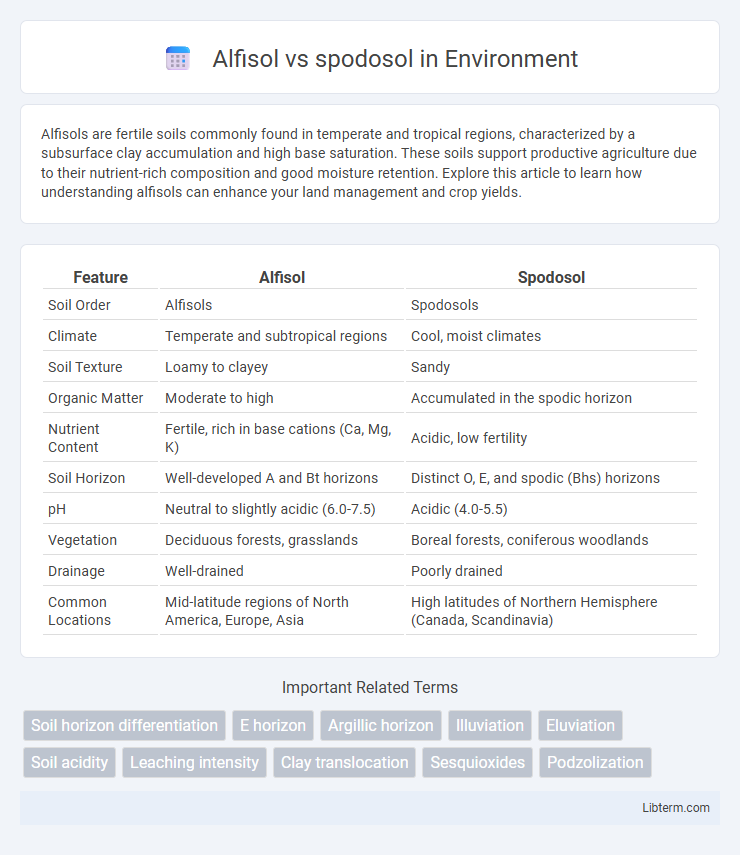Alfisols are fertile soils commonly found in temperate and tropical regions, characterized by a subsurface clay accumulation and high base saturation. These soils support productive agriculture due to their nutrient-rich composition and good moisture retention. Explore this article to learn how understanding alfisols can enhance your land management and crop yields.
Table of Comparison
| Feature | Alfisol | Spodosol |
|---|---|---|
| Soil Order | Alfisols | Spodosols |
| Climate | Temperate and subtropical regions | Cool, moist climates |
| Soil Texture | Loamy to clayey | Sandy |
| Organic Matter | Moderate to high | Accumulated in the spodic horizon |
| Nutrient Content | Fertile, rich in base cations (Ca, Mg, K) | Acidic, low fertility |
| Soil Horizon | Well-developed A and Bt horizons | Distinct O, E, and spodic (Bhs) horizons |
| pH | Neutral to slightly acidic (6.0-7.5) | Acidic (4.0-5.5) |
| Vegetation | Deciduous forests, grasslands | Boreal forests, coniferous woodlands |
| Drainage | Well-drained | Poorly drained |
| Common Locations | Mid-latitude regions of North America, Europe, Asia | High latitudes of Northern Hemisphere (Canada, Scandinavia) |
Introduction to Alfisol and Spodosol
Alfisols are moderately leached soils characterized by a subsurface accumulation of clay and high base saturation, commonly found in temperate forests and grasslands. Spodosols feature a distinct, acidic, and nutrient-poor subsurface horizon formed by the leaching of organic acids, typically occurring under coniferous forests in cooler climates. Both soil orders play crucial roles in forest ecology and land use, with Alfisols supporting agriculture and Spodosols often limiting plant growth due to low fertility.
Formation Processes of Alfisols
Alfisols form primarily through the process of eluviation and illuviation, where clay particles and minerals are leached from the upper horizons and accumulate in the subsurface B horizon, enhancing fertility. These soils typically develop under temperate forests with moderate rainfall, promoting organic matter decomposition and clay translocation. In contrast, Spodosols arise from podzolization, involving intense leaching in acidic, sandy soils commonly found in coniferous forest regions, resulting in a distinct, nutrient-poor, ash-like E horizon.
Formation Processes of Spodosols
Spodosols form primarily in cool, humid climates where intense leaching and acidic conditions lead to the accumulation of organic matter and aluminum and iron oxides in the subsoil, creating a characteristic spodic horizon. In contrast, Alfisols develop under more temperate conditions with moderate leaching, resulting in a well-developed argillic horizon rich in clay minerals and higher base saturation. The distinct formation processes of Spodosols involve podzolization, which emphasizes the translocation and deposition of organic-metal complexes driven by coniferous vegetation and acidic soil solutions.
Key Physical Characteristics
Alfisols exhibit a clay-enriched subsoil horizon with moderate to high base saturation, typically found in temperate forests, featuring a well-defined structure and good water retention. Spodosols are characterized by an acidic, sandy texture with a distinct, leached E horizon and a spodic horizon rich in organic matter and aluminum or iron oxides. Alfisols tend to have higher fertility and nutrient-holding capacity, while Spodosols show lower natural fertility and are often associated with coniferous forest ecosystems.
Chemical Properties Comparison
Alfisols exhibit moderate acidity with a pH typically between 5.5 and 6.5, containing higher levels of base cations like calcium, magnesium, and potassium, which promote nutrient availability. In contrast, Spodosols are strongly acidic, often below pH 5, characterized by low base saturation and high concentrations of aluminum and iron oxides due to intense leaching. The chemical properties of Alfisols support greater fertility and nutrient retention, whereas Spodosols have acidic, nutrient-poor profiles resulting from organic matter accumulation and podzolization processes.
Geographic Distribution and Occurrence
Alfisols are primarily found in temperate regions with deciduous forests, including the Midwest and Eastern United States, parts of Europe, and tropical savannas. Spodosols occur predominantly in cool, humid climates under coniferous forests, commonly distributed across the Northeastern United States, Canada, and Northern Europe. The distinct climatic and vegetative conditions shape Alfisols' nutrient-rich profiles and Spodosols' acidic, organic-rich horizons.
Fertility and Agricultural Potential
Alfisols exhibit high natural fertility due to their moderate to high base saturation and favorable nutrient-holding capacity, making them highly suitable for agriculture, especially for crops requiring well-drained, nutrient-rich soils. Spodosols, characterized by acidic, low base saturation, and accumulation of organic matter and iron/aluminum oxides, tend to have lower natural fertility, which limits their agricultural potential without significant soil amendments. Effective management of Alfisols can sustain long-term crop productivity, while Spodosols often require liming and fertilization to improve pH and nutrient availability for successful cultivation.
Environmental Significance
Alfisols play a critical role in agricultural productivity due to their high fertility and moderate organic matter content, supporting sustainable crop growth in temperate and tropical regions. Spodosols, characterized by acidic and nutrient-poor conditions, are essential for preserving boreal forest ecosystems and mitigating carbon cycling through organic matter accumulation in cool, moist climates. The environmental significance of these soils lies in their distinct contributions to biodiversity, carbon sequestration, and land-use suitability in different ecological zones.
Management Practices
Alfisols require management practices that focus on maintaining soil fertility through the application of lime to correct acidity, along with balanced fertilization to replenish essential nutrients like calcium, magnesium, and potassium. Spodosols benefit from management strategies that prevent nutrient leaching, such as incorporating organic matter to improve soil structure and implementing liming to raise soil pH for better nutrient availability. Crop rotation and careful monitoring of soil pH are crucial in both Alfisol and Spodosol management to sustain productive agricultural systems.
Summary and Future Perspectives
Alfisols, characterized by nutrient-rich, well-drained soils found predominantly in temperate deciduous forests, contrast with Spodosols, which are acidic, sandy soils common in coniferous forest regions. Future research emphasizes sustainable management practices to enhance Alfisol fertility for agriculture while mitigating Spodosol acidification and improving their capacity for carbon sequestration. Advances in soil amendment technologies and remote sensing are expected to optimize land use strategies tailored to these distinct soil orders.
Alfisol Infographic

 libterm.com
libterm.com